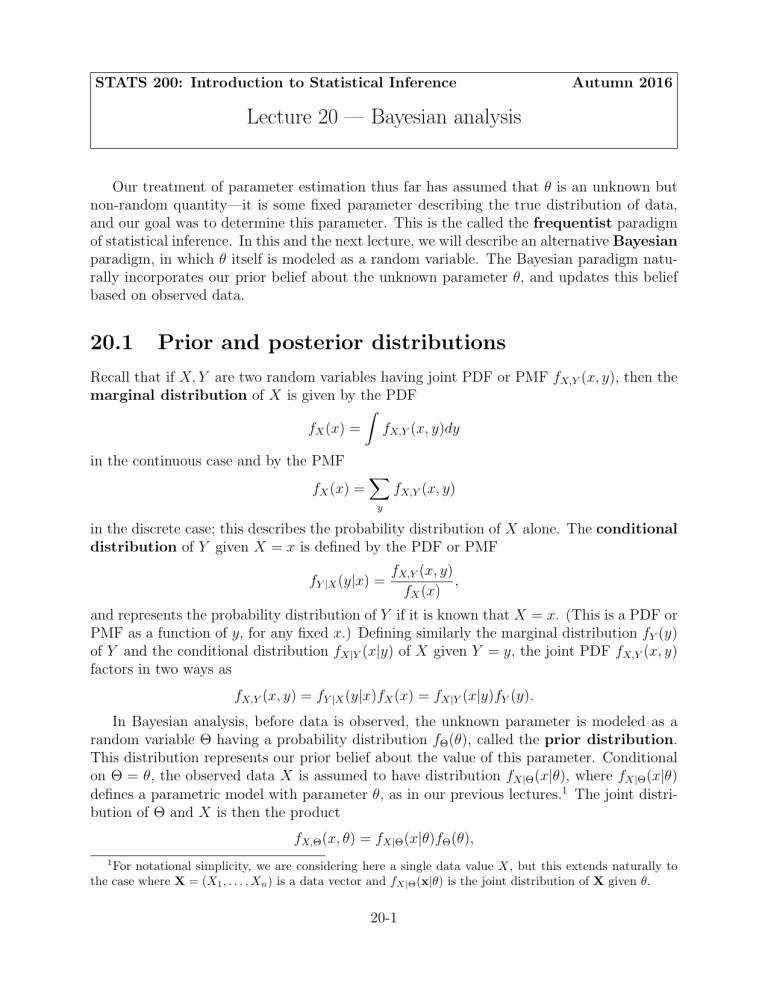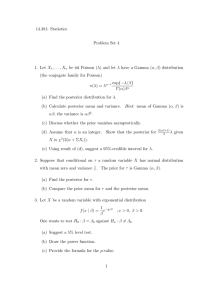
STATS 200: Introduction to Statistical Inference Autumn 2016 Lecture 20 — Bayesian analysis Our treatment of parameter estimation thus far has assumed that θ is an unknown but non-random quantity—it is some fixed parameter describing the true distribution of data, and our goal was to determine this parameter. This is the called the frequentist paradigm of statistical inference. In this and the next lecture, we will describe an alternative Bayesian paradigm, in which θ itself is modeled as a random variable. The Bayesian paradigm naturally incorporates our prior belief about the unknown parameter θ, and updates this belief based on observed data. 20.1 Prior and posterior distributions Recall that if X, Y are two random variables having joint PDF or PMF fX,Y (x, y), then the marginal distribution of X is given by the PDF Z fX (x) = fX,Y (x, y)dy in the continuous case and by the PMF fX (x) = X fX,Y (x, y) y in the discrete case; this describes the probability distribution of X alone. The conditional distribution of Y given X = x is defined by the PDF or PMF fY |X (y|x) = fX,Y (x, y) , fX (x) and represents the probability distribution of Y if it is known that X = x. (This is a PDF or PMF as a function of y, for any fixed x.) Defining similarly the marginal distribution fY (y) of Y and the conditional distribution fX|Y (x|y) of X given Y = y, the joint PDF fX,Y (x, y) factors in two ways as fX,Y (x, y) = fY |X (y|x)fX (x) = fX|Y (x|y)fY (y). In Bayesian analysis, before data is observed, the unknown parameter is modeled as a random variable Θ having a probability distribution fΘ (θ), called the prior distribution. This distribution represents our prior belief about the value of this parameter. Conditional on Θ = θ, the observed data X is assumed to have distribution fX|Θ (x|θ), where fX|Θ (x|θ) defines a parametric model with parameter θ, as in our previous lectures.1 The joint distribution of Θ and X is then the product fX,Θ (x, θ) = fX|Θ (x|θ)fΘ (θ), 1 For notational simplicity, we are considering here a single data value X, but this extends naturally to the case where X = (X1 , . . . , Xn ) is a data vector and fX|Θ (x|θ) is the joint distribution of X given θ. 20-1 and the marginal distribution of X (in the continuous case) is Z Z fX (x) = fX,Θ (x, θ)dθ = fX|Θ (x|θ)fΘ (θ)dθ. The conditional distribution of Θ given X = x is fΘ|X (θ|x) = fX|Θ (x|θ)fΘ (θ) fX,Θ (x, θ) =R . fX (x) fX|Θ (x|θ0 )fΘ (θ0 )dθ0 (20.1) This is called the posterior distribution of Θ: It represents our knowledge about the parameter Θ after having observed the data X. We often summarize the preceding equation simply as fΘ|X (θ|x) ∝ fX|Θ (x|θ)fΘ (θ) (20.2) Posterior density ∝ Likelihood × Prior density R where the symbol ∝ hides the proportionality factor fX (x) = fX|Θ (x|θ0 )fΘ (θ0 )dθ0 which does not depend on θ. Example 20.1. Let P ∈ (0, 1) be the probability of heads for a biased coin, and let X1 , . . . , Xn be the outcomes of n tosses of this coin. If we do not have any prior information about P , we might choose for its prior distribution Uniform(0, 1), having PDF fP (p) = 1 IID for all p ∈ (0, 1). Given P = p, we model X1 , . . . , Xn ∼ Bernoulli(p). Then the joint distribution of P, X1 , . . . , Xn is given by fX,P (x1 , . . . , xn , p) = fX|P (x1 , . . . , xn |p)fP (p) n Y Pn Pn = pxi (1 − p)1−xi × 1 = p i=1 xi (1 − p)n− i=1 xi . i=1 Let s = x1 + . . . + xn . The marginal distribution of X1 , . . . , Xn is obtained by integrating fX,P (x1 , . . . , xn , p) over p: Z 1 fX (x1 , . . . , xn ) = ps (1 − p)n−s dp = B(s + 1, n − s + 1) 0 where B(x, y) is the Beta function B(x, y) = Γ(x)Γ(y) . Γ(x + y) Hence the posterior distribution of P given X1 = x1 , . . . , Xn = xn has PDF fP |X (p|x1 , . . . , xn ) = fX,P (x1 , . . . , xn , p) 1 = ps (1 − p)n−s . fX (x1 , . . . , xn ) B(s + 1, n − s + 1) This is the PDF of the Beta(s + 1, n − s + 1) distribution2 , so the posterior distribution of P given X1 = x1 , . . . , Xn = xn is Beta(s + 1, n − s + 1), where s = x1 + . . . + xn . 2 The Beta(α, β) distribution is a continuous distribution on (0, 1) with PDF f (x) = 20-2 1 α−1 (1−x)β−1 . B(α,β) x We computed explicitly the marginal distribution fX (x1 , . . . , xn ) above, but this was not necessary to arrive at the answer. Indeed, equation (20.2) gives fP |X (p|x1 , . . . , xn ) ∝ fX|P (x1 , . . . , xn |p)fP (p) = ps (1 − p)n−s . This tells us that the PDF of the posterior distribution of P is proportional to ps (1 − p)n−s , as a function of p. Then it must be the PDF of the Beta(s + 1, n − s + 1) distribution, and the proportionality constant must be whatever constant is required to make this PDF integrate to 1 over p ∈ (0, 1). We will repeatedly use this trick to simplify our calculations of posterior distributions. Example 20.2. Suppose now we have a prior belief that P is close to 1/2. There are various prior distributions that we can choose to encode this belief; it will turn out to be mathematically convenient to use the prior distribution Beta(α, α), which has mean 1/2 and variance 1/(8α + 4). The constant α may be chosen depending on how confident we are, a priori, that P is near 1/2—choosing α = 1 reduces to the Uniform(0, 1) prior of the previous example, whereas choosing α > 1 yields a prior distribution more concentrated around 1/2. 1 pα−1 (1 − p)α−1 . Then, applying The prior distribution Beta(α, α) has PDF fP (p) = B(α,α) equation (20.2), the posterior distribution of P given X1 = x1 , . . . , Xn = xn has PDF fP |X (p|x1 , . . . , xn ) ∝ fX|P (x1 , . . . , xn |p)fP (p) ∝ ps (1 − p)n−s × pα−1 (1 − p)α−1 = ps+α−1 (1 − p)n−s+α−1 , where s = x1 + . . . + xn as before, and where the symbol ∝ hides any proportionality constants that do not depend on p. This is proportional to the PDF of the distribution Beta(s + α, n − s + α), so this Beta distribution is the posterior distribution of P . In the previous example, the parametric form for the prior was (cleverly) chosen so that the posterior would be of the same form—they were both Beta distributions. This type of prior is called a conjugate prior for P in the Bernoulli model. Use of a conjugate prior is mostly for mathematical and computational convenience—in principle, any prior fP (p) on (0, 1) may be used. The resulting posterior distribution may be not be a simple named distribution with a closed-form PDF, but the PDF may be computed numerically from equation (20.1) by numerically evaluating the integral in the denominator of this equation. IID Example 20.3. Let Λ ∈ (0, ∞) be the parameter of the Poisson model X1 , . . . , Xn ∼ Poisson(λ). As a prior distribution for Λ, let us take the Gamma distribution Gamma(α, β). The prior and likelihood are given by β α α−1 −βλ λ e Γ(α) n Y λxi e−λ fX|Λ (x1 , . . . , xn |λ) = . x ! i i=1 fΛ (λ) = Dropping proportionality constants that do not depend on λ, the posterior distribution of Λ given X1 = x1 , . . . , Xn = xn is then fΛ|X (λ|x1 , . . . , xn ) ∝ fX|Λ (x1 , . . . , xn |λ)fΛ (λ) ∝ n Y i=1 20-3 (λxi e−λ ) × λα−1 e−βλ = λs+α−1 e−(n+β)λ , where s = x1 + . . . + xn . This is proportional to the PDF of the Gamma(s + α, n + β) distribution, so the posterior distribution of Λ must be Gamma(s + α, n + β). As the prior and posterior are both Gamma distributions, the Gamma distribution is a conjugate prior for Λ in the Poisson model. 20.2 Point estimates and credible intervals To the Bayesian statistician, the posterior distribution is the complete answer to the question: What is the value of θ? In many applications, though, we would still like to have a single estimate θ̂, as well as an interval describing our uncertainty about θ. The posterior mean and posterior mode are the mean and mode of the posterior distribution of Θ; both of these are commonly used as a Bayesian estimate θ̂ for θ. A 100(1−α)% Bayesian credible interval is an interval I such that the posterior probability P[Θ ∈ I | X] = 1 − α, and is the Bayesian analogue to a frequentist confidence interval. One common choice for I is simply the interval [θ(α/2) , θ(1−α/2) ] where θ(α/2) and θ(1−α/2) are the α/2 and 1 − α/2 quantiles of the posterior distribution of Θ. Note that the interpretation of a Bayesian credible interval is different from the interpretation of a frequentist confidence interval—in the Bayesian framework, the parameter Θ is modeled as random, and 1 − α is the probability that this random parameter Θ belongs to an interval that is fixed conditional on the observed data. Example 20.4. From Example 20.2, the posterior distribution of P is Beta(s+α, n−s+α). The posterior mean is then (s+α)/(n+2α), and the posterior mode is (s+α−1)/(n+2α−2). Both of these may be taken as a point estimate p̂ for p. The interval from the 0.05 to the 0.95 quantile of the Beta(s + α, n − s + α) distribution forms a 90% Bayesian credible interval for p. Example 20.5. From Example 20.3, the posterior distribution of Λ is Gamma(s + α, n + β). The posterior mean and mode are then (s + α)/(n + β) and (s + α − 1)/(n + β), and either may be used as a point estimate λ̂ for λ. The interval from the 0.05 to the 0.95 quantile of the Gamma(s + α, n + β) distribution forms a 90% Bayesian credible interval for λ. 20-4




